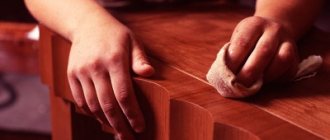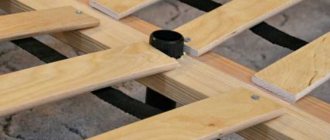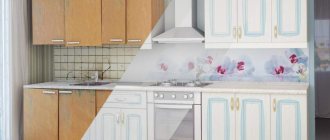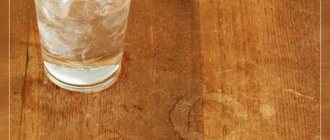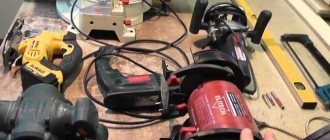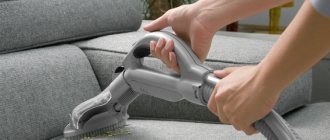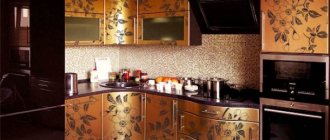The best detergents
It is worth cleaning the kitchen regularly. Wipe table surfaces, sinks, and burners after each use. And the floor - every day, walls, hanging cabinets - once a week. To remove grease, many people use special products that are highly effective.
"Amway"
The concentrated composition is able to remove old stains and drops of grease from smooth surfaces of furniture, sinks, and walls in the kitchen. In addition to effective degreasing, it also produces a pleasant smell in the room. The advantage of the product is the absence of streaks after use, minimum aggressiveness.
Before use, dilute the solution with water in a ratio of 1:4, spraying it on the walls of furniture and walls with a special gun. Then wipe dry.
"Shumanit"
The liquid is suitable for removing stubborn dirt, burnt grease, and oil from smooth furniture facades, stoves, and sinks. The product is used for cleaning household appliances. The countertop and cabinet doors will shine after cleaning. There are no abrasives in the product, so there are no scratches on objects.
Spray the concentrated solution using a dispenser, and then use a soft cloth, napkin, or sponge. The cost-effectiveness of Schumanit allows it to be used for a long time. But many people don't like the strong smell of the cleaning solution.
"Silit Beng"
Ideally cleans surfaces made of modern materials, marble, and stone from layers of fat and oil stains. Do not use the product on wood. It is not used to clean a hot stove; you need to give it time to cool. The composition of the concentrate dissolves grease well if you leave it for half an hour and then wipe it off dirty furniture and walls.
"Mister Muscle"
The versatility of the product is that it can clean all kitchen surfaces: tables, stoves, sinks, tiles, porcelain utensils, inside the microwave oven, ventilation holes, trash can. After spraying, not only old, stubborn stains disappear, but also pathogenic microorganisms that have settled in the kitchen. All that remains is the pleasant citrus scent.
See also
How to clean and how to wash the seams between tiles in the bathroom at home
Effective means
Amway
An effective concentrated degreaser, but not the most aggressive. Can remove even very old stains. It has a pleasant aroma and does not leave streaks.
Schumann
In addition to stubborn stains from grease on furniture, it can also clean household appliances. Maximum delicate, does not scratch the surface. Some people find the smell unpleasant and pungent. But it is economical - the packaging lasts for a long time.
Silit Bang
An excellent concentrate for removing multi-layered fat on kitchen surfaces. Not suitable for use on wooden materials. Valid for half an hour.
Mister Muscle
Suitable for almost all surfaces, even microwaves and vents. Kills harmful microorganisms. Has a pleasant smell.
Rules of application
Shake the bottle of liquid before use. Then spray from a distance of 20 centimeters onto stains or streaks of fat. The gun or bottle must be held vertically.
Before spraying, it is worth testing the cleaning concentrate on a small area of furniture that is not visible to the eye. If the reaction of the façade material is negative, then another chemical is used to remove grease. It is advisable to put rubber gloves on your hands before cleaning and protect your mucous membranes with a mask. You need to use one product, without mixing it with others.
Types of facades and cleaning methods
Kitchen surfaces come in a variety of materials. They react differently to cleaning powders and concentrates. Before cleaning, you need to know everything about the features and methods of cleaning furniture facades.
MDF
Furniture is formed from slabs, which are created by mixing a fine fraction of wood waste and glue. Alcohol-based products should be used when caring for the headset. Do not clean surfaces coated with a special film, toothpastes, baking soda, or salt due to the increased abrasiveness of the substances. Using a steam cleaner can damage furniture, as the film will peel off over time.
Wood
It is better to wipe natural wood cabinets with folk remedies. Use mustard powder, baking soda, salt, and lemon juice to wash the headset. If the furniture is polished, you can return it to its original appearance by wiping it with a slice of raw potato. A steam cleaner for wood must be used carefully to prevent the material from peeling off. It is better to wipe a wooden table with a dry flannel cloth or sponge.
Chipboard
Grease stains on particleboard furniture are wiped off with a damp cloth or napkin soaked in vinegar, alcohol, or acetone. Use a melamine sponge and a solution of laundry soap for cleaning. Stains from hot coffee, chocolate, and wine are removed faster by scrubbing with vodka and sunflower oil.
Laminated chipboard
Tabletops and cabinet furniture are made from laminated chipboard. The glossy surface looks high quality and is easy to care for. Non-aggressive products can be used for cleaning. The set should be washed with a soft cloth or sponge without hard brushes.
Plastic
Plastic kitchen furniture fronts are resistant to abrasive powders, but they should be used carefully. Otherwise, the surface will wear away faster. Do not use products containing chlorine on plastic. Do not use polishes with wax. Sticky surfaces will attract dust, dirt, and grease.
Glass
The fragile material is susceptible to mechanical damage. It is better to wipe glass shelves with a sponge dipped in soapy water. Finally, rinse with clean water and polish with a dry cloth. Alcohol-based window cleaners are also used for cleaning.
Paper towels
The best solution for absolutely any surface is a clean paper towel. It cannot harm any objects, with extremely rare exceptions.
How to use:
- Prepare one towel.
- Moisten it with warm water.
- Wipe every contaminated area.
If you need to remove a fresh stain of grease or other dirt, then this is an ideal option that will instantly solve the problem.
Soap, soda
You can remove grease from most surfaces yourself using baking soda and soap. This is an ideal option for household appliances and dishes.
How to clean:
- Rub the soap into small pieces and add a small amount of water.
- Blot the sponge and wipe off all the dirt.
- Pour baking soda onto a sponge and wipe the dirty surface.
- After 20 minutes, rinse with a soft, damp cloth.
This product cannot be used when cleaning varnish or glossy coatings, as they can be scratched by soda granules.
Traditional methods of cleaning kitchen units
Every housewife has products in her kitchen that are used to clean not only dishes, but also furniture. You just need to know how to use cleaning agents so that grease and oil stains quickly disappear.
Mustard powder
Dry mustard is great for cleaning grease from the walls of cabinets and tables. First you need to rub a damp cloth over the greasy surface, then pour in the powder. It is worth going over the stains several times with a dry cloth, and then rinsing with a damp, clean sponge, wiping thoroughly. Do not use mustard to wash wooden surfaces and MDF furniture.
See also
20 best ways to quickly clean grease from your kitchen hood
Soap and soda
Baking soda and laundry soap are often used to remove dirt on the walls of kitchen furniture, sinks, and household appliances. The cleaning solution is prepared from laundry soap that does not contain fragrances. It’s better to grate a piece and fill it with warm water. Wipe problem areas with soapy liquid. Apply a layer of baking soda on top. Grease is removed using a sponge; the product is rubbed into the furniture material. Finally, rinse off with clean water, wiping dry.
Metal and plastic surfaces are perfectly cleaned with this product. But varnished ones can be scratched by abrasive particles of soda.
Oil and soda
Vegetable and essential oils are used to clean various surfaces, mixed with soda. The product will also help with plaque on sinks. You can mix soda and oil, apply to dirt, stains, and wipe thoroughly. Combine essential oil of eucalyptus and spruce with abrasive powder.
Vinegar
Disinfecting stains on kitchen furniture with vinegar is simple. Use a cloth or sponge moistened with a solution of vinegar and water to rub over fresh stains. You can mix table or apple cider vinegar with alcohol in a 2:1 ratio. This solution will be able to remove old drops of fat. To add freshness, add 1-2 drops of essential oil to the mixture.
Baking powder for the dough
Baking powder contains soda and starch. The powder absorbs fat well. Therefore, after mixing baking powder with water, apply the paste to the stains that need to be removed. After half an hour, wipe thoroughly, rinsing with clean warm water.
Vegetable oil and soda
A folk remedy is suitable for all types of kitchen sets. Before cleaning, mix 2 tablespoons of oil with a spoon of baking soda. The mixture is applied with a sponge to the contaminated areas. Treat surfaces with a soft brush. Then, after keeping the pulp for half an hour, remove it using a damp sponge and a dry soft cloth.
Universal solution with vodka
Vodka is used against oil stains in order to neutralize fatty acids. A mixture of vodka and vinegar has a stronger effect on old fat. Moreover, acids are taken 2 times more. To improve the smell and effectiveness, add a few drops of lemon juice to the solution.
Laundry soap
Ordinary laundry soap can wash away all dirt in the kitchen. The alkaline composition of soap allows you to dissolve grease, so you need to wash your kitchen with a cleaning product every week.
Salt
Table salt is good at removing grease from furniture and walls. But it is dangerous to use an abrasive substance on furniture made of wood or MDF.
You can use salt for cleaning regularly, not forgetting to moisten the countertops and facades before the procedure.
How to clean linoleum and tiles in the kitchen?
It is better to wash linoleum daily with plain water. But if this is not possible, then you can wash the linoleum weekly using a soap solution. In case of severe contamination, add vodka (half a glass of alcohol per 1 liter of water).
But light linoleum can be washed using water from boiled potatoes. Just let it cool.
The tiled floor in the kitchen can be easily washed from dried grease with water and ammonia (per 1 liter - 3 tablespoons of alcohol). To make the tiles shine, you can add a couple of teaspoons of glass cleaner to the solution. And to clean the tile joints, you can use an old toothbrush with washing powder.
Cleaning greasy walls at home
The walls in the kitchen are more likely to get dirty than in other rooms of the house. Drops of fat are especially visible near the stove and sinks. Cleaning vertical surfaces is not easy. It all depends on the wall covering material.
Tile
Tiled walls can be easily cleaned with warm water and ammonia. For 1 liter take 2-3 tablespoons of ammonia. You can wash it by adding drops of glass cleaner, then the tiles will shine. At the end, the walls are wiped with suede.
See also
How to quickly and effectively get rid of mice and rats, 20 home remedies
Dye
On painted surfaces, you can remove stains with soapy water or vinegar. Solvents must not be used, otherwise the walls will have to be repainted.
Wallpaper
Paper wallpaper is cleaned with a rubberized cloth, then vacuumed from top to bottom. Dry cleaning foam suitable for coverings made from natural fibers.
Whitewash
Do not clean whitewashed walls with a damp sponge or cloth. Grease and other stains should be removed by dry cleaning.
Using a Steam Cleaner
On all surfaces that are not afraid of moisture, it is better to remove all stains with a steam cleaner. The device will allow you to quickly cope with cleaning. Under the influence of temperatures, the fat dissolves and can only be removed by wiping with a damp cloth.
Household appliances, floors and other surfaces
Kitchen cleanliness is not only about removing stains from furniture and walls. When tidying up the room, they clean the floor, sinks, stove and household appliances. Washing methods are not much different from each other. They use both detergents from the store and what is on hand: vinegar, mustard, ammonia.
Paper towels
It is better to wipe off a fresh drop of fat or oil immediately using a napkin or paper towel.
Use a damp object to remove streaks of dirt and grease on walls, doors, and countertops.
Soap, soda
Stainless steel appliances are washed with soap and water without soda. It is better to wash stains on the floor with soapy water and sprinkle baking soda on problem areas. Then apply a sponge or soft brush soaked in clean water and wipe dry.
Hydrogen peroxide
A solution of hydrogen peroxide removes any dirt, soot, or oil stains. You need to mix peroxide with soda. The paste is applied to the surface, washed off after 20-30 minutes.
Melamine sponge
A melamine sponge is convenient because the material emits foam when moistened. The product can be used on any surface, removing stubborn stains. Melamine particles should be cleaned off with a dry cloth at the end.
Folk remedies
Before you run to the store for expensive cleaning products, try first washing the kitchen facades of grease using proven methods that have been proven over the years. They have quite a lot of advantages:
- firstly, every housewife, as a rule, has the ingredients;
- secondly, they are very easy to use;
- thirdly, it is environmentally friendly.
Baking soda
Excellent for removing grease from kitchen utensils. The method is suitable for almost any surface. Avoid only varnished and glossy ones, on which soda can leave scratches. Any of the options is recommended to be used every three weeks.
1 option
- Wipe down the cabinets with a wet sponge.
- Mix soda (or baking powder) with water until a mass similar to thick sour cream is formed.
- Gently rubbing, cover the surface of the headset with the mixture and leave for 10 minutes.
- Wipe off any remaining baking soda with a damp sponge.
Option 2
- Blot the kitchen facades with a cloth soaked in hot water - this will soften the greasy coating a little.
- Mix 0.5 tbsp. fine salt, half a glass of soda, add a little water.
- Apply the resulting mixture thickly to grease-contaminated surfaces.
- Rinse off after 20 minutes.
Option 3
- Mix 1 tbsp. soda with half a glass of vegetable (ideally essential) oil.
- Use gentle movements to remove grease from kitchen facades.
- Rinse with warm water.
Attention! This option helps the kitchen not to lose color, and also protects against humidity and dry air.
Option 4
- Grate unscented laundry soap and add a little water to the shavings.
- Apply the resulting mixture to the kitchen surface.
- Apply baking soda on top without rinsing off the soap for 15 minutes.
- Rub the sponge into the grease-contaminated surface and then rinse.
Table vinegar
The best way to clean kitchen cabinets from stubborn dirt and grease is with regular table vinegar. The main condition is not to use on painted surfaces. Vinegar can eat away at paint.
1 option
- Mix 0.5 tbsp. vinegar and 0.5 tbsp. vodka. Add 0.5 tsp. oils
- Pour the mixture into a spray bottle and apply to contaminated areas.
- After 20 minutes, wipe with a dry cloth or towel. No need to rinse with water.
Option 2
- Dampen the kitchen façade with vinegar.
- Cover the top with baking soda.
- Wait until the active reaction is complete, remove with a damp sponge.
Salt
Once a week, kitchen furniture can be treated with salt. It can kill harmful bacteria and prevent the appearance of new ones. It just needs to be applied to the surface with a wet cloth. No rinsing required.
But you can clean kitchen furniture from small stains with a saline solution. Stir 25 g of salt in 1 liter of water at room temperature. Wash away dirt with a soft cloth soaked in the solution. The procedure can be repeated if necessary.
Mustard
Mustard also works well when you need to wash away old fat. But it should not be used for glossy and wooden surfaces.
Wipe the problem area with a damp cloth. Pour the powder onto a dry cloth and rub it over the same areas. You can wait about 15 minutes. Remove any remaining residue with a damp cloth. Repeat if necessary.
Ammonia
Ammonia will clean your kitchen unit well from oil stains. Mix alcohol and water in equal quantities. Pour the solution into a spray bottle. For a pleasant smell and enhanced effect, you can add a little lemon juice. First, wet the kitchen facade with plain water, and then spray with a solution of ammonia. Wash off the dirt with a soft sponge and then dry with a flannel cloth.
Hydrogen peroxide
You can remove grease from kitchen cabinets with peroxide. It will also return whiteness if required. Accordingly, this liquid should not be used for a dark kitchen.
1 option
- Mix peroxide with soda in a ratio of 1:2.
- Thickly cover the desired areas with the resulting mixture.
- After 15 minutes, you can easily wash off the grease with a sponge or rag, even from the hood.
Option 2
- Dissolve 1 tbsp in 1 liter of water. l. peroxide and 1 tbsp. l. salt.
- Treat the kitchen with the resulting solution, leave for 10-15 minutes.
- Wipe with a soft cloth.
Preventive measures
You can protect furniture from dirt if you take care of it, removing dust deposits in a timely manner and eliminating stains. It is advisable that:
- Keeping the kitchen moderately damp and dry will prevent the cabinets from cracking and staining.
- Try not to grab furniture doors with your fingers.
- Do not open coloring alcohol tinctures on unprotected countertops.
- Seal the cracks in the wood with beeswax in a timely manner.
- If lime or paint gets on the walls, immediately wipe it with a rag soaked in vinegar and vegetable oil.
By protecting kitchen items and taking proper care of them, you extend their service life.


